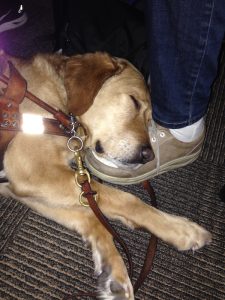After receiving so many comments to my Wednesday post about service dogs, I phoned Melissa Allman, Esq,, the Advocacy and Government Relations specialist at Seeing Eye. I thought you blog readers would be interested in seeing what their take is on the plans to amend and clarify regulations implementing the Air Carrier Access Act, and she gave me permission to share the text of their comment here:

Whitney’s graduation picture. (Courtesy The Seeing Eye.)
The Seeing Eye has been providing specially bred and trained guide dogs for people who are blind or have low vision since 1929. Since that time, The Seeing Eye has worked tirelessly to advocate for the rights of guide dog users to have equal access to all modes of transportation including air travel. At present, there are over 1,700 active Seeing Eye graduates in North America and many of those people are regular air travelers. As Senior Advocacy Specialist and a guide dog handler myself, I am submitting the below comments on behalf of The Seeing Eye. I commend DOT’s efforts to amend and clarify its ACAA regulations to ensure safe and equal access to air travel for people who work with service animals. The Seeing Eye’s position on the questions posed in the ANPRM is as follows:
Question 1: Whether psychiatric service animals should be treated similarly to other service animals; Question 2: Whether there should be a distinction between emotional support animals and other service animals;
Comments to questions 1 and 2: Service animals should be defined as those that are 1) individually trained to do work or perform tasks for a person with a disability and 2) public access trained. Animals that do not meet both of these criteria should be designated as a separate and distinct category from service animals.
Question 3: whether emotional support animals should be required to travel in pet carriers for the duration of the flight;
Comment: Animals should be permitted to travel in the cabin without being crated as long as they meet the criteria in the definition of service animal proposed in comments 1 and 2.
Question 4: Whether the species of service animals and emotional support animals that airlines are required to transport should be limited;
Comment: With respect to the species of service animals, the amended DOT regulations should be consistent with the Department of Justice regulations implementing the Americans with Disabilities Act. The result would be that the species of service animals would be limited to dogs and in some narrow circumstances, miniature horses.
Question 5: whether the number of service animals/emotional support animals should be limited per passenger;
Comment: The Seeing Eye is concerned that as the number of service animals traveling with a handler increases, the likelihood that the handler will be able to effectively control the animals decreases.
Question 6: Whether an attestation should be required from all service animal and emotional support animal users that their animal has been trained to behave in a public setting;
Comment: No. An attestation would have no value because passengers could provide assurances that the animal is trained to behave appropriately in public regardless of the animal’s actual behavior and there would be no way to determine the veracity of these statements. Existing guidelines allow airlines to refuse to transport service animals that are engaging in disruptive or threatening behavior such as excessive barking, biting, growling, jumping, eliminating in the terminal or aircraft, etc. Furthermore, if the definition of service animal is limited to those that are trained to perform work or tasks and public access trained, and all other animals were required to be in pet carriers, airlines would be far less likely to have problems with unruly or aggressive animals.
Question 7: Whether service animals and emotional support animals should be harnessed, leashed, or otherwise tethered;
Comment: Service animals should be leashed or otherwise under the handler’s control at all times. There are times during air travel when it may be appropriate for a passenger using a guide dog to remove its harness for the comfort and safety of the dog. However, the guide dog handler still has control over the dog in these limited circumstances because the leash is the means of control.
Question 8: Whether there are safety concerns with transporting large service animals and if so, how to address them;
Comment: If DOT adopts the definition of service animal proposed in comments 1 and 2, these safety concerns would be greatly decreased. On page 34, The ANPRM states in part that “Airlines have … expressed safety concerns about large service animals in the cabin, particularly large emotional support animals that have not received disability-mitigation training. … While the Department previously concluded that a service animal’s reasonable use of a portion of an adjacent seat’s foot space does not deny another passenger effective use of the space for his or her feet and is not an adequate reason for the carrier to refuse to permit the animal to accompany its user at his or her seat, some airlines have indicated that passengers feel pressured to agree to such an arrangement and have later expressed to airline personnel their dissatisfaction at having to share their foot space.”
If DOT requires air carriers to transport only dogs that are trained to mitigate a disability and behave appropriately in public, it will be easier for air carriers to simultaneously accommodate passengers using service animals and assuage the potential concerns of passengers who are being asked to help make that accommodation possible.
Question 9: whether airlines should be prohibited from requiring a veterinary health form or immunization record from service animal users without an individualized assessment that the animal would pose a direct threat to the health or safety of others or would cause a significant disruption in the aircraft cabin;
Comment: Yes. Airlines should be prohibited from requiring a veterinary health form or immunization record from service animal users in advance of travel. This requirement would place burdens and restrictions on service animal users that are not placed on other passengers. For example, the requirement could prevent service animal users from traveling on short notice or checking in on line or at curb side. Moreover, once an air carrier has made an individualized assessment that a service animal would pose a direct threat or cause a significant disruption in an aircraft cabin, veterinary records do nothing to mitigate the threat the animal potentially poses and DOT regulations do not obligate air carriers to transport the animal under those circumstances.
In closing, The Seeing Eye expresses its appreciation to DOT for the opportunity to participate in the advanced rule making process on an issue that is of paramount importance to our organization as a whole and our graduates as individuals. If The Seeing Eye can provide any further assistance or information on issues raised in this ANPRM given our areas of expertise, please feel free to contact us.
Melissa R. Allman, Esq.
Senior Specialist, Advocacy and Government Relations The Seeing Eye







